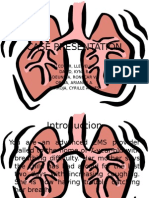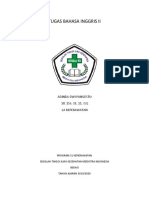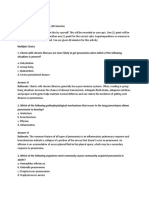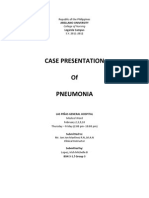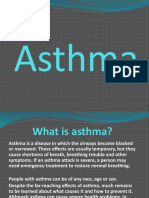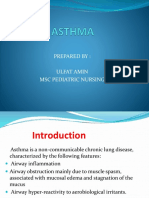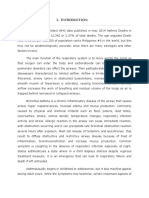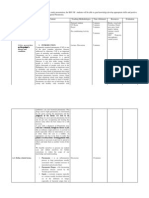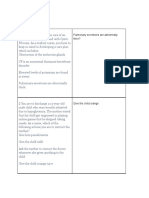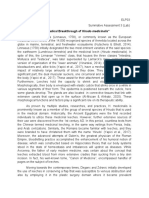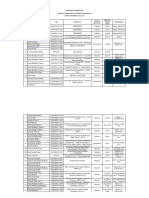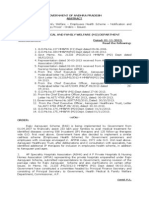Lower Respiratory Disorders Case Study Asthma
Lower Respiratory Disorders Case Study Asthma
Uploaded by
Elsayed MohamedCopyright:
Available Formats
Lower Respiratory Disorders Case Study Asthma
Lower Respiratory Disorders Case Study Asthma
Uploaded by
Elsayed MohamedOriginal Title
Copyright
Available Formats
Share this document
Did you find this document useful?
Is this content inappropriate?
Copyright:
Available Formats
Lower Respiratory Disorders Case Study Asthma
Lower Respiratory Disorders Case Study Asthma
Uploaded by
Elsayed MohamedCopyright:
Available Formats
Lower respiratory disorders case study
History
Bradley is a 8-year-old boy who is seen in the ER. He has coughs and wheezes
frequently, several viral illnesses per year. First, and most severe episode, occurred
when he was 7 months old. He has had many courses of antibiotics over the last few
years for chest infections, also he has bulky, offensive stools. Now he is came with
asthmatic episode. His mother reports that last time he was nearly transferred to the
pediatric intensive care unit (PICU) with chest infection. He has developed a cold and
become acutely breathless and physician prescribed salbutamol inhaler hourly but
without much relief.
Examination
Bradley is sitting up in bed with a nebulizer in progress containing 5 mg salbutamol.
His Oxygen saturation on 15 L of oxygen on arrival is documented as 89 per cent. He
is quiet but able to answer questions with short sentences. His chest is hyper inflated
(increased anteroposterior diameter) and he is using his accessory muscles of
respiration. His respiratory rate is 60 breaths/min and he has marked intercostal and
subcostal retraction. On auscultation there is equal but poor air entry with widespread
expiratory wheeze. His temperature is 38.6_C. His pulse is 180 beats/min with good
perfusion. He is small (height ninth centile, weight second centile), pale-looking,
miserable and very dependent on his mother. He has finger clubbing. His abdomen is
mildly distended but non-tender.
Questions
1. What is the most likely underlying cause for this acute episode?
An:
The respiratory infection and the recurrent of this infection is the most likely
underlying cause for this acute episode.
2. What is the likely underlying companying diagnosis based on the
clinical presentation?
An:
Cystic Fibrosis
3. What signs would you look for of impending respiratory failure?
An:
Shortness of breathing, tachypnea, cyanosis, confusion, tachycardia, nose
flaring, retraction, sweating and wheezing.
4. Outline your management plan for this acute episode
An:
Chest PT BID
Medication
Beta2 Agonist as bronchodilator
D-Nase or Pulmozyme these decrease the viscosity of mucus
Ibuprofen twice daily
Exercise
Early treatment of infections with antibiotics
5. What should happen before he is discharged?
Give teaching about the home care
Teaching must be done with each discharge.
CPT
Providing breathing treatments
Medication administration at home
Some families will go home with nursing care to provide IV antibiotics at home.
6. This child is in school age and needs to be cautioned regarding
practicing exercise, explain this statement?
The child should avoid exercise during the episode period and maintain clean,
healthy environment and avoid dust and fumes as this may lead to infection
again.
7. Chest physiotherapy is applicable for child with asthma? And what its
importance of it for the other diagnosis?
An:
Yes, it’s as it helps to remove and expel the mucus which was accumulated in
the airway as this is the cause of the air trapping and the respiratory problem.
8. How to maintain adequate growth and development for this child?
An:
Maintain the hydration and increase the fluid intake.
Provide the appropriate nutritional intake for the child to maintain growth and
development and increase high calorie intake and administer oxygen therapy
to improve the respiratory function and increase SPO2
You might also like
- Ep9 A2Document75 pagesEp9 A2lijiana100% (1)
- Marquez - Case Study 4Document4 pagesMarquez - Case Study 4Caren MarquezNo ratings yet
- Case Study (Asthma)Document3 pagesCase Study (Asthma)AIM50% (4)
- Peds Exam 2 Review QuestionsDocument11 pagesPeds Exam 2 Review Questionschristalh7460% (5)
- Global Medical DevicesDocument50 pagesGlobal Medical DevicesLavanya Subramaniam100% (1)
- Session 5Document3 pagesSession 5Sistine Rose Labajo100% (3)
- Asthma - Case PresentationDocument56 pagesAsthma - Case Presentationsarooah199471% (7)
- CASE STUDY: Bronchial Asthma in Acute Exacerbation: EtiologyDocument35 pagesCASE STUDY: Bronchial Asthma in Acute Exacerbation: EtiologyMishiel Castillo100% (1)
- Soal MCQDocument39 pagesSoal MCQYhoooga100% (2)
- Cardiovascular and CerebrovascularDocument6 pagesCardiovascular and CerebrovascularJoshelle B. Bancilo0% (1)
- Base IOA N Non Ioa ALL 1200 Pages Labels 15.o1.xiDocument1,192 pagesBase IOA N Non Ioa ALL 1200 Pages Labels 15.o1.xiAnonymous RjIueYSl100% (2)
- Pneumonia QuizDocument7 pagesPneumonia QuizJennah JozelleNo ratings yet
- Wheezy InfantDocument3 pagesWheezy InfantAzizan HannyNo ratings yet
- Work SheetDocument5 pagesWork Sheettefesih tube ተፈስሕ ቲዮብNo ratings yet
- MCN 109 A Well High Risk Compilation of ExamsDocument204 pagesMCN 109 A Well High Risk Compilation of ExamsChristine Airah Tanaliga100% (1)
- Pediatric Asthma TBL QuestionsDocument4 pagesPediatric Asthma TBL QuestionsVladimir BasurtoNo ratings yet
- Pediatric AsthmaDocument63 pagesPediatric Asthmasrober0565No ratings yet
- Case Study (Asthma)Document3 pagesCase Study (Asthma)AIM100% (1)
- Influenza QuizDocument6 pagesInfluenza QuizJennah JozelleNo ratings yet
- QCW1Document4 pagesQCW1Ljc JaslinNo ratings yet
- 2.5. Flu-Like IllnessDocument24 pages2.5. Flu-Like IllnessM HNo ratings yet
- Case Presentation: Alcover, Llewell T. David, Kyna B. Deunida, Ronecar V. Obida, Arianne A. Tarroja, Cyrille AgnesDocument36 pagesCase Presentation: Alcover, Llewell T. David, Kyna B. Deunida, Ronecar V. Obida, Arianne A. Tarroja, Cyrille AgnesKBDNo ratings yet
- Case Study Asthma Group 2Document17 pagesCase Study Asthma Group 2Kennedy PelicoNo ratings yet
- AEMT - Obstetrics and Pediatrics Exam PracticeDocument26 pagesAEMT - Obstetrics and Pediatrics Exam PracticeEMS DirectorNo ratings yet
- Tugas Bahasa Inggris Ii: Adinda Dwi Pangestu 18. 156. 01. 11. 002 2A KeperawatanDocument5 pagesTugas Bahasa Inggris Ii: Adinda Dwi Pangestu 18. 156. 01. 11. 002 2A KeperawatanAdinda Dwi PangestuNo ratings yet
- Sas 5Document7 pagesSas 5Rodesa MigarNo ratings yet
- Sas 20Document4 pagesSas 20Sistine Rose LabajoNo ratings yet
- Pediatric Nursing - Respiratory DisordersDocument9 pagesPediatric Nursing - Respiratory Disordershasan ahmdNo ratings yet
- Pediatric Respiratory EmergencyDocument35 pagesPediatric Respiratory EmergencyImran FaisalNo ratings yet
- Nclex Practice Exam For Pediatric NursingDocument13 pagesNclex Practice Exam For Pediatric NursingRobert brian2001No ratings yet
- Asthma Case Report FinalDocument6 pagesAsthma Case Report FinalJiaYee Go0% (1)
- Pneumonia Case StudyDocument21 pagesPneumonia Case StudyShiri Michelle Lopez Cayton100% (2)
- Nursing Interventions: Asthma: PathoDocument4 pagesNursing Interventions: Asthma: Pathomische20No ratings yet
- Case Study 1Document7 pagesCase Study 1Hasnain KhanNo ratings yet
- Case 1 (Pneumonia) ArioDocument26 pagesCase 1 (Pneumonia) ArioJoegie ArioNo ratings yet
- Can You Explain What Is Asthma and How Do You Educate Patient About Asthma. AnswerDocument8 pagesCan You Explain What Is Asthma and How Do You Educate Patient About Asthma. AnswerMohamad RafliNo ratings yet
- Bronchiolitis Clinical Practice GuidelineDocument21 pagesBronchiolitis Clinical Practice GuidelineYenni AndrianaNo ratings yet
- Bronchiolitis ScriptDocument6 pagesBronchiolitis ScriptAhmed RmelahNo ratings yet
- Asthma!!!Document18 pagesAsthma!!!Jabbamackeez67% (3)
- A Child With WheezeDocument53 pagesA Child With WheezeCodillia CheongNo ratings yet
- Case Study PedsDocument11 pagesCase Study PedsGenesis Bicera100% (1)
- Bronchiolitis Clinical Practice GuidelineDocument21 pagesBronchiolitis Clinical Practice GuidelineJuwita PratiwiNo ratings yet
- English Task: Arranged By: Shinta Hardiyanti 18.156.01.11.062 2B NursingDocument5 pagesEnglish Task: Arranged By: Shinta Hardiyanti 18.156.01.11.062 2B NursingIntan PutriiNo ratings yet
- Cough and Dyspnea Case StudyDocument4 pagesCough and Dyspnea Case StudyAbigail Balbuena100% (1)
- Recurrent Wheeze in Pre-School Children: Respiratory MedicineDocument5 pagesRecurrent Wheeze in Pre-School Children: Respiratory MedicinejprakashjjNo ratings yet
- TCP PneumoniaDocument6 pagesTCP PneumoniaAnonymous FgT04krgymNo ratings yet
- AsthmaDocument2 pagesAsthmaJelen EndiapeNo ratings yet
- 5 Cough TranscriptDocument11 pages5 Cough Transcriptmantshamaeko1No ratings yet
- Assignment For Oxy. Online BasedDocument5 pagesAssignment For Oxy. Online BasedNurhassem Nor AkangNo ratings yet
- Name: Yeti Muliani Class: 1A Nim: 20.043 Subject: English Lecturer: Ririn Yosep Hanna. S. Pane, M.Pd. Assignment: Skimmming and Scanning TextDocument6 pagesName: Yeti Muliani Class: 1A Nim: 20.043 Subject: English Lecturer: Ririn Yosep Hanna. S. Pane, M.Pd. Assignment: Skimmming and Scanning TextYeti MulianiNo ratings yet
- Prepared By: Ulfat Amin MSC Pediatric NursingDocument25 pagesPrepared By: Ulfat Amin MSC Pediatric NursingAngelic khanNo ratings yet
- Case Study: Chronic Obstructive Pulmonary DiseaseDocument13 pagesCase Study: Chronic Obstructive Pulmonary DiseaseJohn Vincent Canillas PedregozaNo ratings yet
- IntroductionDocument14 pagesIntroductiontaekado-1No ratings yet
- Control of Acute Respiratory Infections 2Document6 pagesControl of Acute Respiratory Infections 2إحسان ماجد محمدNo ratings yet
- Acute Respiratory InfectionsDocument26 pagesAcute Respiratory InfectionsSuneel SagareNo ratings yet
- Imci Test Quest SamplerDocument6 pagesImci Test Quest Samplerjenalyn_ingaran_sanluisNo ratings yet
- FL15 Pneumonia 2016 v4 PDFdownloadDocument5 pagesFL15 Pneumonia 2016 v4 PDFdownloadvivek yadavNo ratings yet
- A.Hislop ERS Course April 07Document93 pagesA.Hislop ERS Course April 07minerva_stanciuNo ratings yet
- CasesDocument25 pagesCasesfatemaNo ratings yet
- General ObjectivesDocument28 pagesGeneral ObjectivesMei MeiNo ratings yet
- Untitled DocumentDocument42 pagesUntitled Documentallkhusairy6tuansiNo ratings yet
- Presented By: MANOJ MANDAL 1 Year P.C BSC NSG, Mibe, GSNDocument42 pagesPresented By: MANOJ MANDAL 1 Year P.C BSC NSG, Mibe, GSNfurr singhNo ratings yet
- QCM Ped PulmoDocument8 pagesQCM Ped PulmoWahbi KhalidNo ratings yet
- Positive Options for Children with Asthma: Everything Parents Need to KnowFrom EverandPositive Options for Children with Asthma: Everything Parents Need to KnowNo ratings yet
- Daftar Obat Expired Tahun 2022Document2 pagesDaftar Obat Expired Tahun 2022klinik unpNo ratings yet
- July 28Document8 pagesJuly 28thestudentageNo ratings yet
- Pedia Recommended DosageDocument5 pagesPedia Recommended DosageNerak LuNo ratings yet
- Mnemonic of Some Rare Genetic Disease PDFDocument9 pagesMnemonic of Some Rare Genetic Disease PDFfaraz100% (1)
- Gait Speed TUGDocument3 pagesGait Speed TUGMuhammad Bayu Zohari HutagalungNo ratings yet
- Confined Space Emergency Rescue Plan: Document No - RevDocument17 pagesConfined Space Emergency Rescue Plan: Document No - RevIdris AdeniranNo ratings yet
- Upper Extremity Venous Protocol 14Document2 pagesUpper Extremity Venous Protocol 14api-349402240No ratings yet
- Summative Assessment 4 LabDocument5 pagesSummative Assessment 4 Laban Odd IntrovertNo ratings yet
- Final SCIDocument65 pagesFinal SCIiamjenivicNo ratings yet
- CH 46 Complications of AnaesthesiaDocument29 pagesCH 46 Complications of AnaesthesiaChristian LeepoNo ratings yet
- Pediatric Drug Dosage - All in OneDocument15 pagesPediatric Drug Dosage - All in OneBJ Tiew100% (1)
- Immunomodulatory Activity of BhallatakDocument35 pagesImmunomodulatory Activity of BhallatakBalaji Kumar PanigrahiNo ratings yet
- Diet and Dental CariesDocument10 pagesDiet and Dental Cariessh1minhNo ratings yet
- Mahasiswa Berprestasi TH 20177Document14 pagesMahasiswa Berprestasi TH 20177novi.esti93No ratings yet
- 15 - Levels of Organization ReadingDocument3 pages15 - Levels of Organization Readingapi-262360890No ratings yet
- Accomplishment Report TemplateDocument6 pagesAccomplishment Report TemplateSample BakeshopNo ratings yet
- Pa RagisDocument11 pagesPa RagisVal FielNo ratings yet
- Infinichi Secrets of The IchingDocument39 pagesInfinichi Secrets of The Ichingjuanp1020100% (4)
- Final Therapy PricesDocument133 pagesFinal Therapy PriceskandukurisrimanNo ratings yet
- Reporting Incompetent DoctorsDocument9 pagesReporting Incompetent DoctorsNewfaceNo ratings yet
- Cardiology I WorkbookDocument68 pagesCardiology I WorkbookPharmacist DinaNo ratings yet
- Snake BiteDocument18 pagesSnake BiteRejana JonesNo ratings yet
- Henry's Clinical Diagnosis and Management by Laboratory Methods. 22nd Edition. ISBN 1437709745, 978-1437709742Document23 pagesHenry's Clinical Diagnosis and Management by Laboratory Methods. 22nd Edition. ISBN 1437709745, 978-1437709742lesliteirtzalux100% (17)
- Khan A. 2023. Respiratory Management of Patients With Neuromuscular WeaknessDocument139 pagesKhan A. 2023. Respiratory Management of Patients With Neuromuscular WeaknessFermin LombardiaNo ratings yet
- NeulinDocument3 pagesNeulinRinGo PleNo ratings yet
- Journal Significance of Reconstitution Time For Dry Powder InjectablesDocument3 pagesJournal Significance of Reconstitution Time For Dry Powder InjectablesHoan doNo ratings yet





















